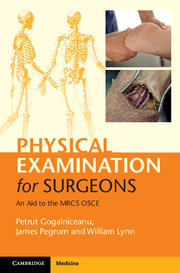Book contents
- Frontmatter
- Dedication
- Contents
- List of contributors
- Introduction
- Acknowledgments
- List of abbreviations
- Section 1 Principles of surgery
- Section 2 General surgery
- Section 3 Breast surgery
- Section 4 Pelvis and perineum
- Section 5 Orthopaedic surgery
- 14 Generic joint examination
- 15 Examination of gait
- 16 Examination of the cervical and thoracic spine
- 17 Cervical spine injury: assessment in trauma
- 18 Examination of the shoulder
- 19 Examination of the elbow
- 20 Examination of the lumbar spine and sacroiliac joint
- 21 Examination of the hip
- 22 Examination of the knee
- 23 Examination of the ankle
- Section 6 Vascular surgery
- Section 7 Heart and thorax
- Section 8 Head and neck surgery
- Section 9 Neurosurgery
- Section 10 Plastic surgery
- Section 11 Surgical radiology
- Section 12 Airway, trauma and critical care
- Index
17 - Cervical spine injury: assessment in trauma
from Section 5 - Orthopaedic surgery
Published online by Cambridge University Press: 05 July 2015
- Frontmatter
- Dedication
- Contents
- List of contributors
- Introduction
- Acknowledgments
- List of abbreviations
- Section 1 Principles of surgery
- Section 2 General surgery
- Section 3 Breast surgery
- Section 4 Pelvis and perineum
- Section 5 Orthopaedic surgery
- 14 Generic joint examination
- 15 Examination of gait
- 16 Examination of the cervical and thoracic spine
- 17 Cervical spine injury: assessment in trauma
- 18 Examination of the shoulder
- 19 Examination of the elbow
- 20 Examination of the lumbar spine and sacroiliac joint
- 21 Examination of the hip
- 22 Examination of the knee
- 23 Examination of the ankle
- Section 6 Vascular surgery
- Section 7 Heart and thorax
- Section 8 Head and neck surgery
- Section 9 Neurosurgery
- Section 10 Plastic surgery
- Section 11 Surgical radiology
- Section 12 Airway, trauma and critical care
- Index
Summary
Rules
• All trauma patients have a C-spine injury until proven otherwise.
• Patient's neck can be cleared by radiographic or clinical means.
Clinical clearance requires:
1. No high-risk factors regarding the injury, such as:
a. diving or axial injury
b. fall from height >3 feet (90 cm)/five steps
c. high-speed car collision >60 mph (97 km/h)
d. bike or recreational vehicle collision
2. No high-risk factors regarding the patient:
a. age >65 or <16
b. intoxicated or altered mental status
c. GCS <15
d. abnormal neurology
e. no distracting injuries
f. midline cervical tenderness
Clinical clearance system
1. Completion of ATLS primary survey.
2. History regarding the event and evaluation of the patient for risk factors.
3. Assessment for the presence of distracting injuries (presence of distracting injuries requires cervical imaging).
4. Full neurological examination.
5. In-line immobilisation of C-spine and removal of collar.
6. Second assessor palpates cervical spine. If there is no pain the patient is then asked to actively rotate the head left and right.
7. If there is still no neck pain or numbness/tingling in the limbs the cervical spine can be cleared without radiographic evaluation.
Radiographic clearance system
• Cervical spine radiographs (See Chapter 49, Cervical spine x-ray):
• AP and lateral views.
• All C1–7 and superior aspect of T1 vertebrae must be visualised.
• Swimmer's view or traction on arms (if traumatic injury permits) are needed if standard views are inadequate.
• Current recommendations are for computed tomography (CT) imaging.
- Type
- Chapter
- Information
- Physical Examination for SurgeonsAn Aid to the MRCS OSCE, pp. 138 - 139Publisher: Cambridge University PressPrint publication year: 2015



